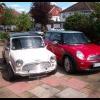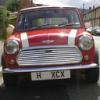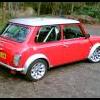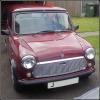If still under BMW ownership ........pretty much like it is now as Rover did most of the engineering and development at Gaydon anyway, although without the BMW reliability requirements it would almost certainly have used the Rover K Series engine, instead of just the Rover Midland gearbox mated to the robust Chrysler Tritec engine.
Without BMW investment and ownership..........the classic Mini would have ended around 1997 due to tightening emmisions amd safety legislation with no MPI Mini upgrade to extend it to 2000. No Mini replacement could have been afforded by Rover on their own (small cars = low profit margins)..........if Rover had had the necessary cash investment to go it alone, then the Spritual Rover design prototypes suggest we would have got a Mercedes A-Class style of small car with none of the fun sporting drive or Cooper heritage of the classic Mini carried over.
As Mini enthusists, we were of course lucky to have the classic Mini in production for so long from 1959-2000, mainly due to the typically British lack of investment in the long term future of the brand and the difficulty of successfully replacing something so iconic in motoring history.
However sales figures and profits are important for any company, no car company is in business for reasons of charity or nostaglia.
The Mini sales figures peaked at 318,000 in 1971 declined through the later 1970's, down to 150,000 in 1980 just before the Metro was introduced, then a large drop to 70,000 for 1981 after the Metro. From this point on sales continued downward each year with a small increase around 1990/91 to 46,000 due to the re-introduction of the Rover Cooper.
When BMW took over from BAe in 1994 annual Mini sales were down to 20,000 and Rover were having difficulty with some component suppliers due to the low production volumes, after the end of the A series engined Metro range. AP who built the Automatic transmissions were threatening to stop supplies as such low numbers were becoming uneconomic in modern car industry terms.
Despite the BMW MPI upgrades and increased marketing efforts, sales continued to decline to around 10-12,000 a year until end of production in 2000............although the world car buying public still loved the Mini and its image they were no longer buying it in sufficient numbers.
Production of the New MINI (R50) started at 100,000 per year from 2001, (the full capacity of the Oxford factory paint shop), with further factory investment this had doubled to 200,000 per year by 2005.
Until the recent industry turn down production capacity was 240,000 per year or 800 MINI's a day, but even these figures are too small for a unique car in modern small car production so sadly future MINI's will probably have to share their chassis and components with other makes like a new Fiat Punto, etc. This has already happened with the New Fiat 500 which shares its platform with the Fiat Panda and New Ford KA built in the same factory with cheaper labour in Poland.
Edited by mab01uk, 30 December 2008 - 03:01 PM.





























